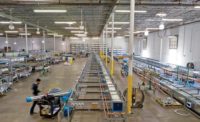"We were unable to close main lanes during the day to speed up work due to expensive lane-rental fees," says Luis Muñoz, CEO of Trinity Infrastructure. "Strategic traffic sequencing quickly became the focus of our team in order to open up larger work areas, all while maintaining traffic throughout the corridor."
Main-lane closures could only happen at night and on weekends. To date, crews have executed more than 14,000 lane closures. The contractor has assigned 60 employees, including three full-time co-located traffic engineers, solely to traffic-control operations.
Traffic management must take into account delivery of equipment and materials. More than 4,000 beams have been installed, about 66% of the project total. At peak construction, 82 cranes and 450 units of equipment were on site. That's not counting the more than 30,000 delivery tickets per month, building team officials say. Careful planning and workarounds have enabled the team to handle the logistics without major issues.
Another challenge is working in a narrow urban corridor with many franchise utilities that provide services to adjacent properties, which makes the number of service lines significantly higher than on a smaller highway improvement project.
"Design teams were able to design around utility and right-of-way issues early in the project so that construction could proceed," Muñoz says. "Our collaborative teams—including technical design, construction and all of our subcontractors—operate in real time, allowing them to address issues and implement changes in the field quickly so that no production time is lost."
So far, the team has encountered 223 utility conflicts and relocated 500,000 linear ft of lines.
"We have more than 2,000 people working daily on the LBJ Express, with 95% of the work subcontracted out," Filer says. The team has hired more than 150 subcontractors so far, including 80 disadvantaged business enterprise companies that have 200-plus contracts totaling $187 million, Filer says.
The team has also pushed to keep workers safe, reporting a recordable injury rate of 1.4 in 2013 and 0.8 so far this year, with just 70 recordables from project start through April with 11 million man-hours worked.
Pushing Innovation
Given the project's location and space constraints, innovative solutions were critical. Team officials describe as unique the excavation of the U-section, where managed lanes will be depressed, and the reconstruction of the general purpose lanes above the excavated area, which will create a cantilevered effect.








Post a comment to this article
Report Abusive Comment